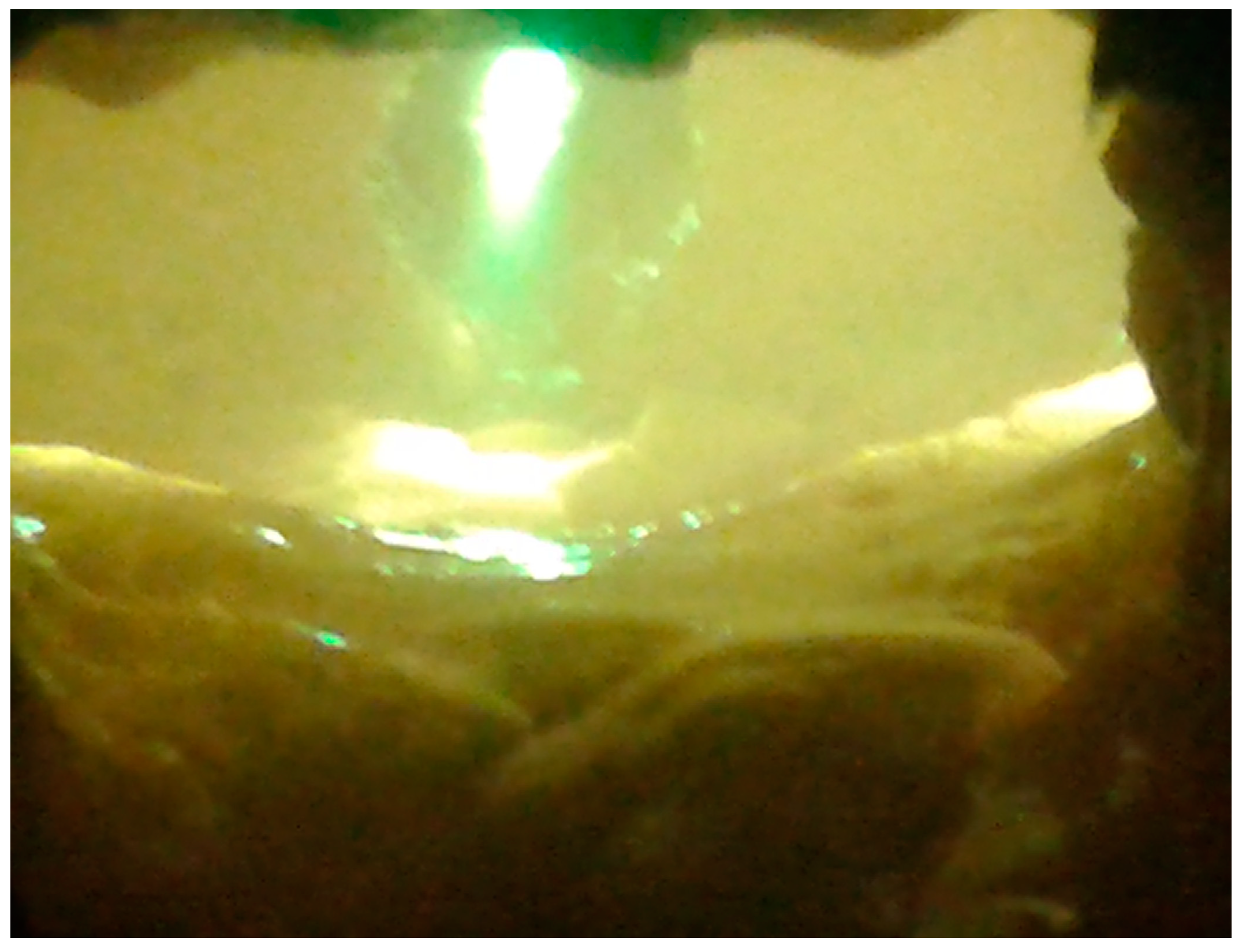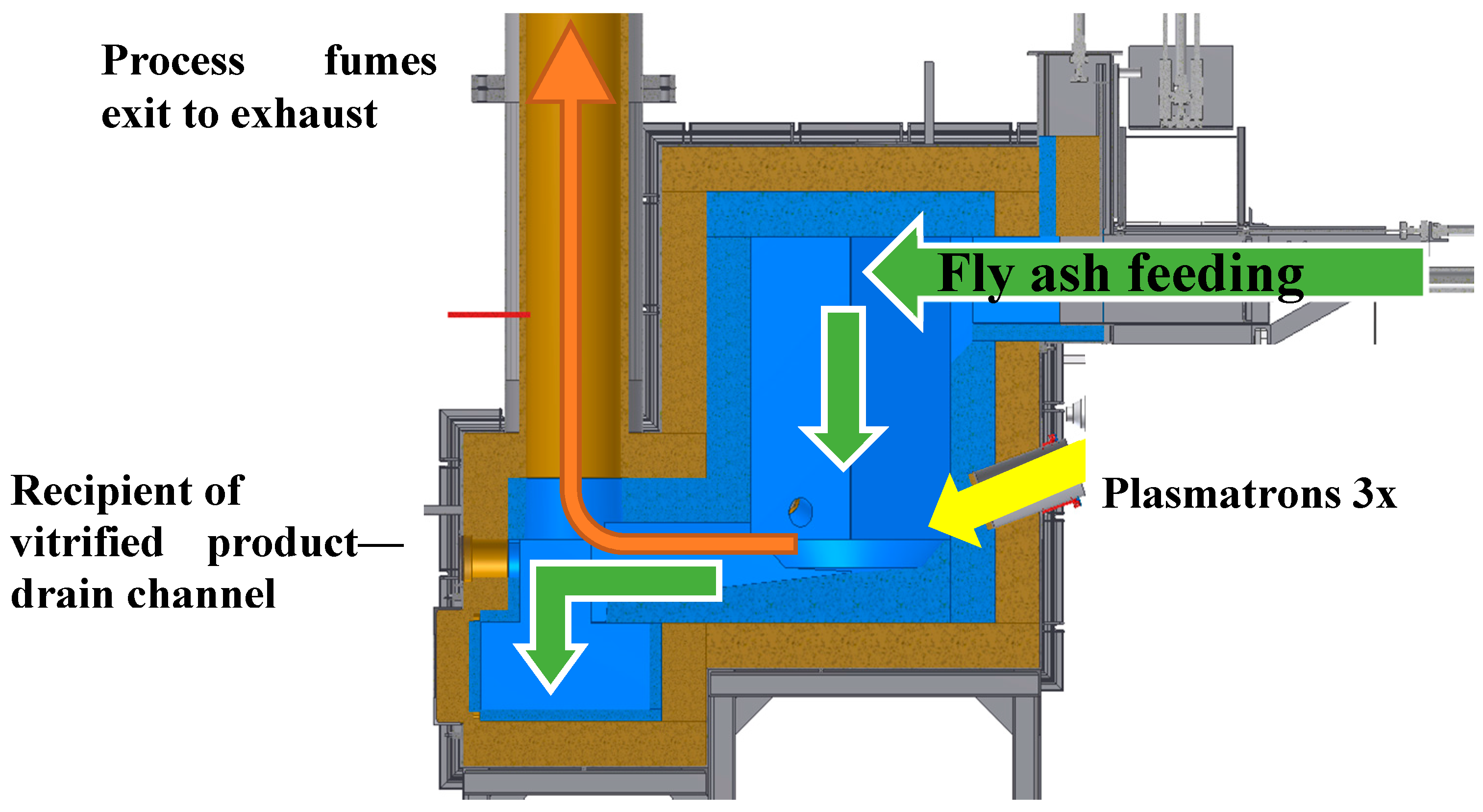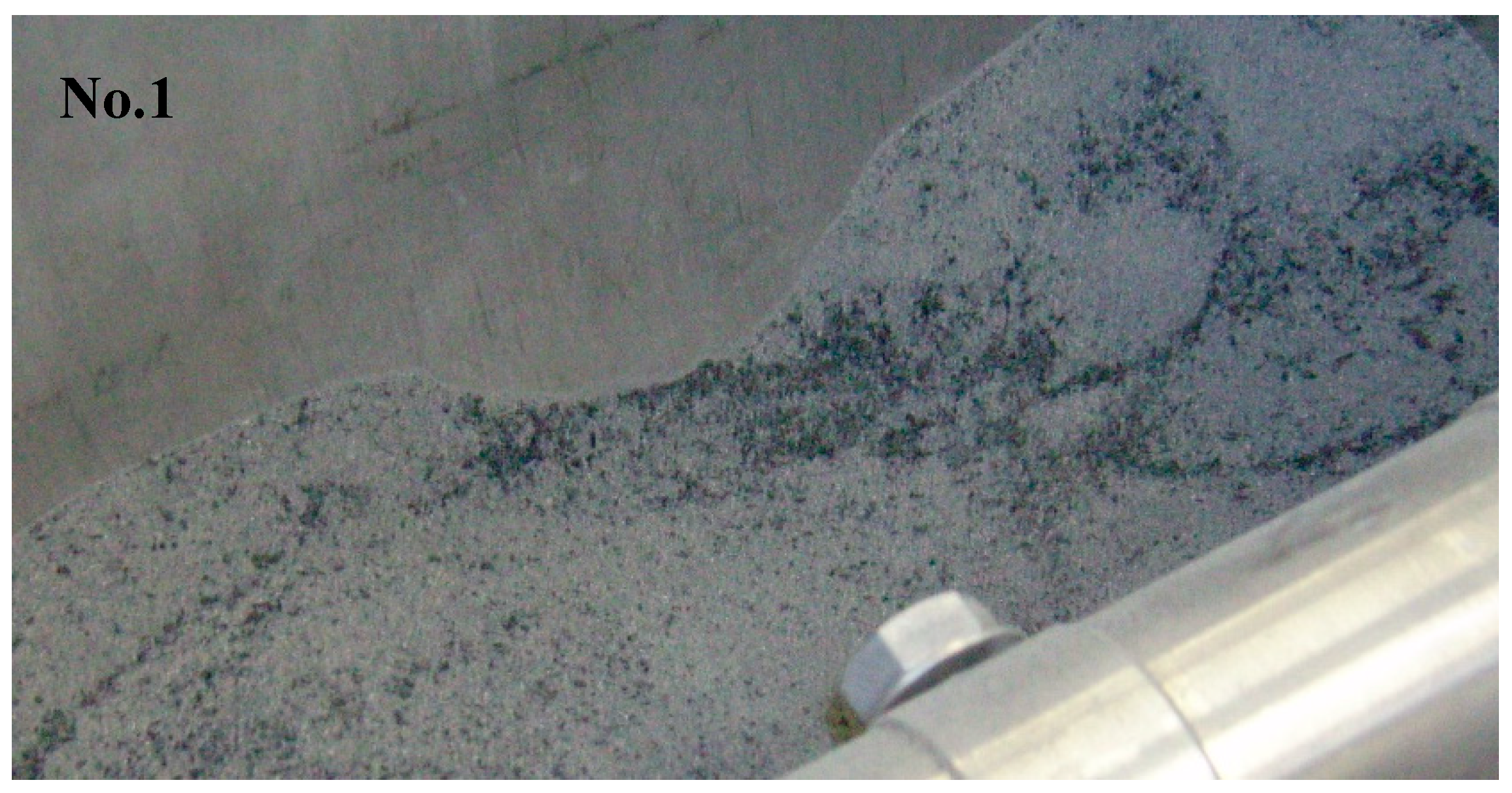Construction Materials from Vitrified Lignite Fly Ash in Plasmatron Plasma Reactor
Abstract
1. Introduction
2. Materials and Methods
2.1. Lignite Fly Ash Samples
2.2. Vitrification Process Description
3. Results and Discussion
3.1. Experimental Results
3.2. Elemental Analysis of Vitrified Samples
3.3. Power Consumption
4. Potential Application of Vitrified Materials Formed from Lignite Fly Ash—Alternative Building Materials and Inert Aggregate for Civil Engineering
5. Conclusions
- (1)
- does not leak any harmful substances to the environment and the material meets all of necessary access criteria for its use as building material in construction industry,
- (2)
- the density of the produced material is above 2 g/cm3 which is favorable in construction industry and civil engineering,
- (3)
- the vitrified product is hard, as its hardness is higher than quartz which equals to >7 in Mohs scale,
- (4)
- it is dense: compared to the volume of raw lignite fly ash it is only 36% volume of the input material.
Funding
Conflicts of Interest
References
- Terzić, A.; Pavlović, L.; Miličić, L. Evaluation of Lignite Fly Ash for Utilization as Component in Construction Materials. Int. J. Coal Prep. Util. 2013, 33, 159–180. [Google Scholar] [CrossRef]
- Li, X.; Ma, X.; Zhang, S.; Zheng, E. Mechanical Properties and Microstructure of Class C Fly Ash-Based Geopolymer Paste and Mortar. Materials 2013, 6, 1485–1495. [Google Scholar] [CrossRef] [PubMed]
- Hower, J.C.; Granite, E.J.; Mayfield, D.B.; Lewis, A.S.; Finkelman, R.B. Notes on Contributions to the Science of Rare Earth Element Enrichment in Coal and Coal Combustion Byproducts. Minerals 2016, 6, 32. [Google Scholar] [CrossRef]
- Ram, L.C.; Srivastava, N.K.; Jha, S.K.; Sinha, A.K.; Masto, R.E.; Selvi, V.A. Management of Lignite Fly Ash for Improving Soil Fertility and Crop Productivity. Environ. Manag. 2007, 40, 438–452. [Google Scholar] [CrossRef] [PubMed]
- Janoš, P.; Buchtová, H.; Rýznarová, M. Sorption of dyes from aqueous solutions onto fly ash. Water Res. 2003, 37, 4938–4944. [Google Scholar] [CrossRef] [PubMed]
- Baukal, C. (Ed.) Oxygen-Enhanced Combustion; CRC Press: Boca Raton, FL, USA, 2013; p. 466. [Google Scholar]
- Hyun, J.S.; Park, J.W.; Maken, S.; Park, J.J. Vitrification of fly and bottom ashes from municipal solid waste incinerator using Brown’s Gas. J. Ind. Eng. Chem. 2004, 10, 361–367. [Google Scholar]
- Mitsubishi Heavy Industries Web Page, Incinerator Ash Vitrification Facility. Available online: https://tetronics.com/assets/Case-Study-Mitsubishi_FlyAsh.pdf (accessed on 28 October 2018).
- Szałatkiewicz, J.; Budny, E.; Szewczyk, R. Modelling of thermodynamics, mass exchange and heat transfer of plasmatron plasma reactor for recycling of used electric and electronic components. J. KONES 2016, 23, 357–363. [Google Scholar] [CrossRef]
- Mohs Scale of Hardness. Available online: https://en.wikipedia.org/wiki/Mohs_scale_of_mineral_hardness (accessed on 27 February 2019).
- Wystalska, K.; Bień, J. Stałe i gazowe produkty uzyskane w procesie plazmowego przekształcania odpadów. Ochr. Środowiska I Zasobów Nat. 2007, 33, 87–91. [Google Scholar]






| Element | SiO2 | TiO2 | Al2O3 | Fe2O3 | MnO | MgO | CaO | Na2O | K2O | P2O5 | SO3 |
|---|---|---|---|---|---|---|---|---|---|---|---|
| Sample | % | ||||||||||
| No. 1 | 36.5 | 1.5 | 10.4 | 2.5 | 0.02 | 0.6 | 13.2 | 0.1 | 0.1 | 0.04 | 0.6 |
| No. 2 | 22.3 | 2.2 | 17.4 | 4.3 | 0.07 | 1.1 | 15.6 | 1.6 | 1.2 | 0.1 | 2.9 |
| Vitrification Parameters | Sample No. 1 | Sample No. 2 |
|---|---|---|
| Total average electrical power consumption by the setup during experiment | 60 kW | 65 kW |
| Total electrical power consumed by the stand during the experiment, divided by the sample mass | 3.5 kWh/kg | 4.9 kWh/kg |
| Fly ash mass in the experiment (feed continuously) | 5.5 kg | 6 kg |
| Vitrified mass left after the experiment: | 4.3 kg (78% of input mass) | 5.2 kg (86% of input mass) |
| Time of sample feeding Average processing speed | 19 min 0.288 kg/min | 27 min 0.22 kg/min |
| Start temperature of the process: | 1410 °C | 1419 °C |
| End temperature of the process: | 1445 °C | 1468 °C |
| Element | SiO2 | TiO2 | Al2O3 | Fe2O3 | MnO | MgO | CaO | Na2O | K2O | P2O5 | SO3 |
|---|---|---|---|---|---|---|---|---|---|---|---|
| Sample | % | ||||||||||
| No. 1 | 32.5 | 1.4 | 9.4 | 3.5 | 0.05 | 0.4 | 12.4 | 0.3 | 0.2 | 0.03 | 0.1 |
| No. 2 | 22.0 | 1.9 | 13.7 | 4.9 | 0.07 | 0.6 | 16.2 | 1.0 | 1.2 | 0.1 | 0.1 |
| Element | Leaching Sample No. 2 (mg/kg) | Leaching Sample No. 1 (mg/kg) | Permissible Limiting Value for Leaching (mg/kg) |
|---|---|---|---|
| As | <0.02 | <0.02 | 0.5 |
| Sb | 0.02 | 0.01 | 0.06 |
| Ba | 0.02 | 0.03 | 0.5 |
| Cd | <0.01 | <0.01 | 0.04 |
| Cr total | 0.03 | <0.01 | 0.5 |
| Cu | 0.1 | 0.1 | 2 |
| Ni | <0.02 | 0.21 | 0.4 |
| Pb | <0.05 | <0.05 | 0.5 |
| Zn | <1 | <1 | 4 |
| Se | <0.02 | <0.02 | 0.1 |
| Mo | <0.01 | 0.06 | 0.5 |
| Hg | <0.003 | <0.003 | 0.01 |
| Analyzed Sample | Alkaline Reactivity (%) | Fulfilling Requirements |
|---|---|---|
| No. 1 | 0.04 –> level 0 | level 0 |
| No. 2 | 0.08 –> level 0 |
© 2019 by the author. Licensee MDPI, Basel, Switzerland. This article is an open access article distributed under the terms and conditions of the Creative Commons Attribution (CC BY) license (http://creativecommons.org/licenses/by/4.0/).
Share and Cite
Szałatkiewicz, J. Construction Materials from Vitrified Lignite Fly Ash in Plasmatron Plasma Reactor. Materials 2019, 12, 905. https://doi.org/10.3390/ma12060905
Szałatkiewicz J. Construction Materials from Vitrified Lignite Fly Ash in Plasmatron Plasma Reactor. Materials. 2019; 12(6):905. https://doi.org/10.3390/ma12060905
Chicago/Turabian StyleSzałatkiewicz, Jakub. 2019. "Construction Materials from Vitrified Lignite Fly Ash in Plasmatron Plasma Reactor" Materials 12, no. 6: 905. https://doi.org/10.3390/ma12060905
APA StyleSzałatkiewicz, J. (2019). Construction Materials from Vitrified Lignite Fly Ash in Plasmatron Plasma Reactor. Materials, 12(6), 905. https://doi.org/10.3390/ma12060905




